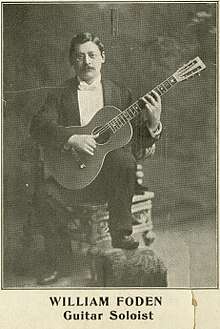William Foden
| William Foden | |
|---|---|
 William Foden, 1918. | |
| Background information | |
| Born |
March 23, 1860 St. Louis, Missouri, U.S. |
| Died | April 9, 1947 (aged 87) |
| Genres | Classical |
| Occupation(s) | Musician, composer, teacher |
| Instruments | Guitar |
| Years active | 1880–1940 |
William Foden (23 March 1860 – 9 April 1947) was an American composer, musician, and teacher. Foden is considered America's premiere classical guitarist during the 1890s and the first decades of the twentieth century.[1]
Life

Foden was born in St. Louis, Missouri and initially started with the violin at age 7, changing from age 16 to the mandolin and classical guitar. He studied guitar with William O. Bateman (1825–1883), "a successful lawyer, music engraver, guitarist, and nationally recognized guitar composer"[2] His professional career began in the 1880s, gaining national notoriety from the early 1890s. "Having an aversion to traveling and leaving his family, he did not fully capitalize on his growing fame"[3] until 1904, when he was invited to play at Carnegie Hall.[4]
In 1911, Foden and his family moved to Englewood, New Jersey,[5] near New York City, after a successful eight-month tour of the United States and British Columbia together with Giuseppe Pettine (mandolin) and Frederick Bacon (banjo), with newspapers referring to them as "The Big Trio".[6] At Englewood, he taught guitar and other fretted instruments at a studio at 42nd Street. For the publisher Wm. J. Smith he arranged numerous works for mandolin orchestra, guitar, banjo, ukulele, and Hawaiian steel guitar. His Grand Guitar Method in two volumes (1920, 1921) contains numerous original compositions, in addition to nearly 50 solo compositions published independently. He also left more than a hundred compositions and arrangements in manuscript.
Music
According to Back (2007),[7] Foden's works may be divided into two categories, a) light popular compositions in established dance forms such as waltzes, marches, polkas, primarily written to provide an income, and b) virtuoso original compositions, including works with theme and variations and often in an extended form, to suit as showpieces in his own performances. Stylistically, he followed older European composers such as Sor, Mertz, and Zani de Ferranti, but Foden is always original in his inventive modulations and unusual choice of keys.[8] He was especially famous for his extraordinary tremolo technique.
Selected works
All for (classical) guitar. Dates are for publications, not necessarily for composition.
- Celebrated Diamond Clog (1887)
- Flower Girl Schottische (1887)
- Il Grande (1890)
- La Ballerina Waltz (1890), also version for 2 guitars
- Enchantment (1892)
- Chevalier March (1895)
- Esperanza (1896)
- Grand Valse Caprice (1896)
- Preludes (1896)
- Serenata (1896)
- Barcarolle (1919)
- Don't Forget to Write to Me Darling (Varied) (1919)
- Maritana (Grand Selections) (1919)
- Minuet in F major (1919)
- 'Tis the Last Rose of Summer (Varied) (1919)
- Capitol March (1920)
- Grand Fantasie of American Songs (1920)
- Grand Fantasie on 'Annie Laurie' (1920)
References
- ↑ Douglas Back, in the preface to the edition of Foden's Grand Sonata in G major, Digital Guitar Archive (DGA Editions, 2007), p. 3.
- ↑ D. Back (2007), as above.
- ↑ D. Back (2007), as above.
- ↑ Hannu Annala, Heiki Matlik (2010), Handbook of Guitar and Lute Composers, ISBN 9781609743536
- ↑ Proctor, Owen. "Author explores folk music roots in NJ", The Record (Bergen County), April 20, 2017. Accessed September 15, 2017. "New Jersey’s role in what is recognized as folk’s roots goes back to the early 1900s, when St. Louis native William Foden moved to Englewood. He was a guitar virtuoso, noted Gabriele."
- ↑ D. Back (2007), as above.
- ↑ As above.
- ↑ D. Back (2007), p. 4.
External links
- Works by or about William Foden at Internet Archive
- Free scores by William Foden at IMSLP